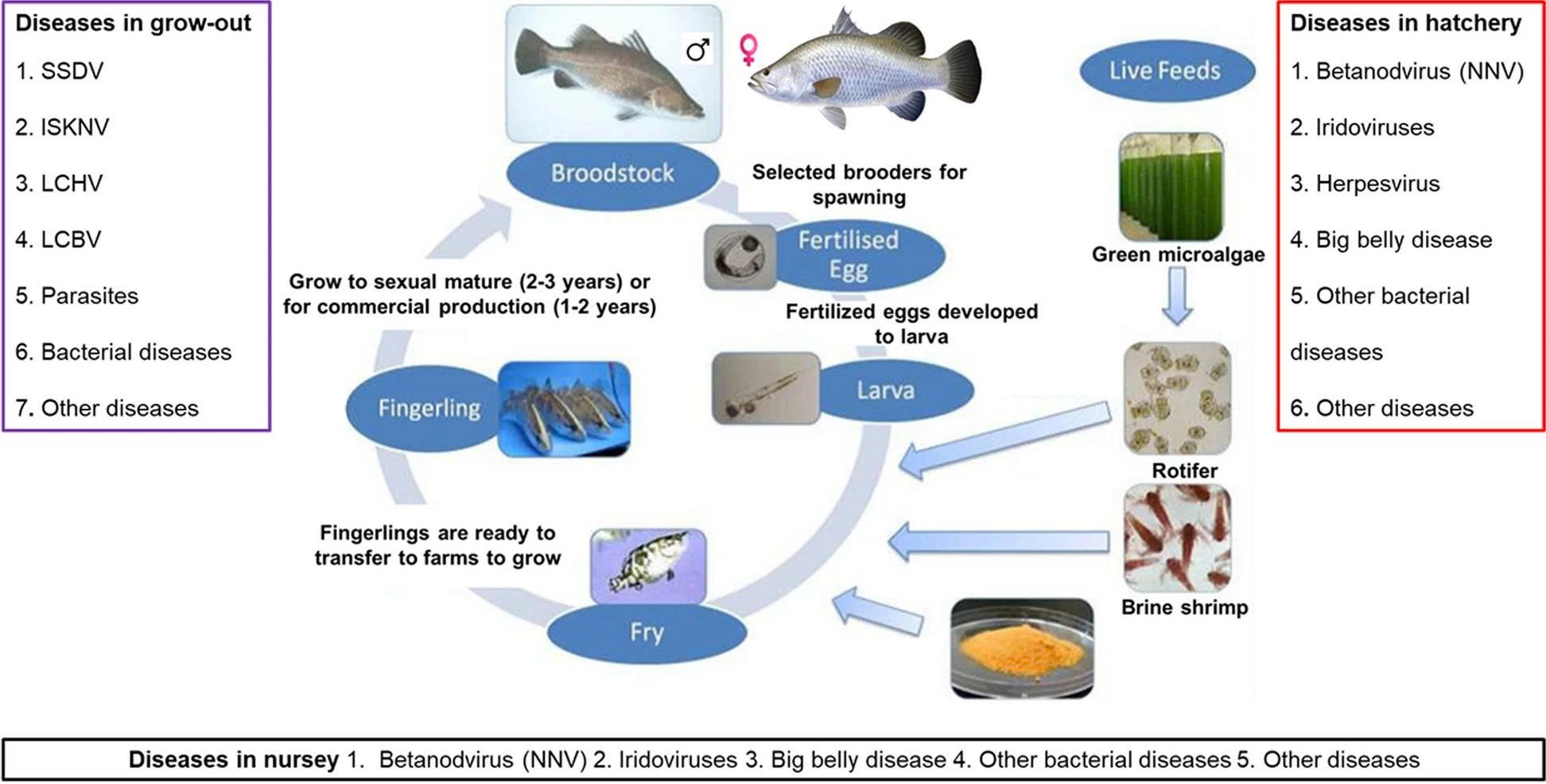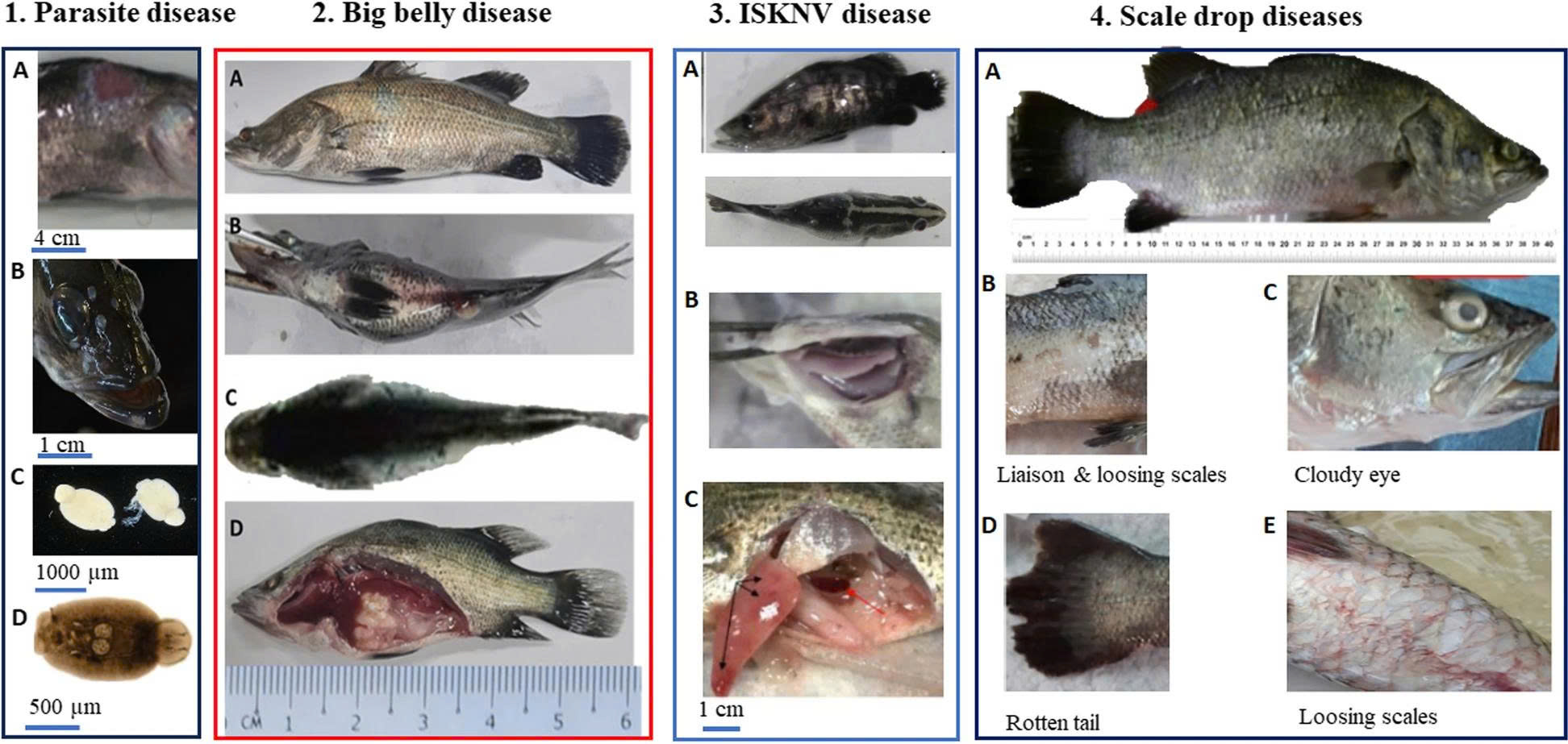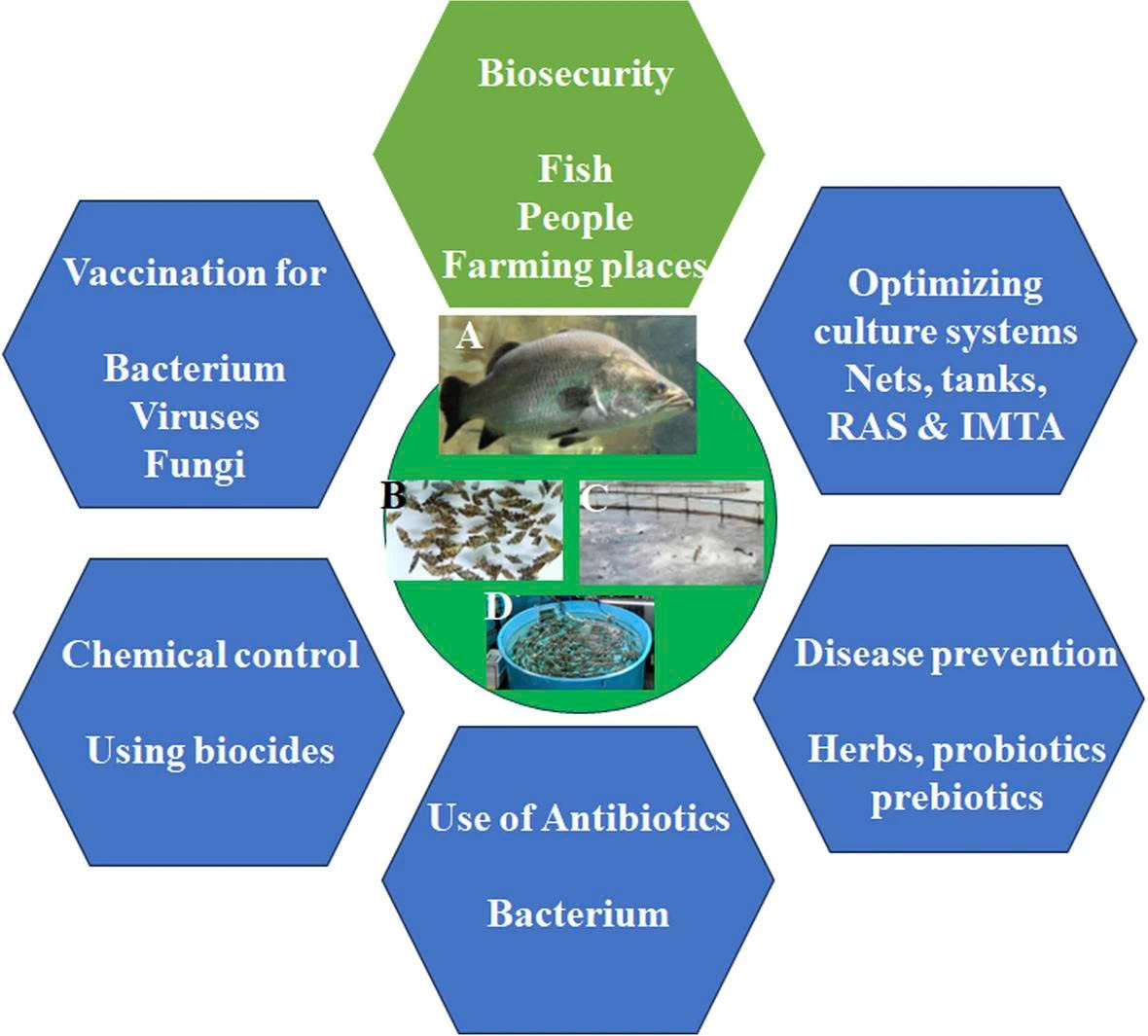1. Introduction
The Asian seabass, also known as baramundi, is a popular species in aquaculture due to its fast growth rate, adaptability to various environmental conditions, and delicious white flesh. With annual production exceeding 120,000 tons, it is a commercially significant species in the Asia-Pacific region. Major producers include Thailand, Malysia, Indonesia, and Australia. The species is known for its sustainability, as it can be farmed in closed systems, reducing the environmental impact of traditional open-sea fishing. However, it faces challenges from diseases such as vibriosis, streptococcosis, viral nervous necrosis, and parasitic infections. These diseases cause symptoms such as skin lesions, organ damage, neurological issues, and mass mortalities, leading to significant economic losses and threats to food security. This review examines major diseases affecting Asian seabass aquaculture, aiming to support its health and ensure a stable seafood supply.
2. Pathogens, etiology, and symptoms

Figure 1: Major disease occurrence attributed to various pathogens in different stages of the life cycle of Asian seabass (Lates calcarifer). NNV: Nervous necrosis virus; SDDV: Scale drop disease virus; LCHV: Lates calcarifer herpesvirus; Infectious spleen and kidney necrosis virus; ISKNV: Infectious spleen and kidney necrosis virus; LCBV: Lates calcarifer birnavirus; BBD: Large belly disease-causing bacterial pathogens

Figure 2: Overview of symptomatology in Asian seabass (Lates calcarifer) arising from four major diseases caused by diverse pathogens in aquaculture settings. 1. Monogenean parasitism by Neobenedenia: A: An Asian seabass specimen exhibiting infection by Neobenedenia. B: Visible parasites on the fish's head. C: Neobenedenia parasites. D: Neobenia monogeneans observed via microscopy. 2. Big belly disease (BBD) triggered by bacterial infection: A: Healthy Asian seabass fingerling for comparison. B: Fingerling manifesting as BBD, characterized by an enlarged abdomen. C: Fingerling affected by BBD, displaying a darkened dorsal surface. D: Fingerling with BBD, showing symptoms not specified. 3. Infectious spleen and kidney necrosis virus (ISKNV) infection: A: Juvenile Asian seabass showing a darkened body due to ISKNV infection. B: Affected juveniles displaying symptoms of gill lamellar fusion, with the gills becoming pale and swollen. C: Signs of hepatic necrosis, liver inflammation, potential bleeding, kidney tissue necrosis, inflammation, and degradation. 4. Scale drop disease (SDD) induced by SDD virus: A: A maturing seabass infected with SDDV. B and C: Exhibiting lesions, scale loss, and cloudiness of the eyes. D: Presence of tail rot. E: Notable for scale loss on the abdomen
2.1 Viral diseases
Iridoviruses, large, double-stranded DNA viruses, are a significant threat to various aquaculture species, including Asian seabass. Key pathogens include Lates calcarifer iridovirus (LCIV), ISKNV, and Singapore grouper iridovirus (SGIV). SDDV, also known as Lates calcarifer iridovirus (LCIV), is a significant viral pathogen that affects Asian seabass and other aquaculture species. It is a member of the genus Megalocytivirus and is closely related to other megalocytiviruses. SDDV is primarily transmitted through horizontal routes, where the virus is directly spread from infected fish to susceptible fish. Waterborne transmission is a significant mode of spread within aquaculture facilities. Clinical signs of SDDV infection in Asian seabass include dropping scales, lethargy, skin discoloration, rotting tails, and reduced appetite. In severe cases, the disease can lead to high mortality rates for Asian seabass aged between 4 and 24 months and weighing 0.2 to 4 kg, causing substantial economic losses in aquaculture operations. ISKNV can be categorized into three distinct genotypes: genotype I (ISKNV-I), genotype II (ISKNV-II), and genotype III. ISKNV-I has high mortality rates, especially in juvenile fish, with outbreaks often leading to significant economic losses in aquaculture. ISKNV-III primarily infects marine fish species, including Asian seabass. SGIV is a highly pathogenic member of the Megalocytivirus genus within the Iridoviridae family.
Nervous necrosis virus (NNV), a viral pathogen, affects various aquaculture species, including Asian seabass, and marine and freshwater species. It is a small, nonenveloped, single-stranded RNA virus that targets the central nervous system of infected young fish, leading to severe neurological symptoms and mortality. NNV is highly contagious, causing up to 90% mortality and substantial economic losses in juveniles. It is prevalent in Southeast Asia, Australia, and India, impacting production and necessitating biosecurity and management efforts. Transmission occurs through horizontal and vertical routes, posing a significant challenge for the aquaculture industry.
Lates calcarifer birnavirus (LCBV) is a viral pathogen that targets the immune and nervous systems of Asian seabass, leading to high mortality rates. Symptoms include lethargy, reduced feeding, abnormal swimming, swollen abdomen, pale gills, eye anomalies, and skin lesions. Severe outbreaks can result in mortality spikes, affecting aquaculture industries, causing economic losses and impacting food security.
Lates calcarifer herpesvirus (LCHV), a recently discovered virus, infects Asian seabass, causing significant problems in aquaculture. It can cause sudden mortality spikes, causing death rates reaching 50%. Infected fish show decreased appetite, lethargy, and abnormal swimming behavior. LCHV can cause internal bleeding and organ inflammation. Researchers are working to understand and control the virus.
2.2 Bacterial diseases
Vibrio spp. are gram-negative bacteria found in aquatic environments, including the pathogenic species Vibrio harveyi. These bacteria are associated with fish diseases, such as vibriosis in Asian seabass. Vibriosis occurs when virulent strains of V. harveyi enter fish populations through various routes, including the gills, skin, and gastrointestinal tract. Factors like stress, wounds, and environmental conditions can facilitate the entry of bacteria. V. harveyi colonizes tissues, including the intestine and blood, and possesses virulence factors like toxins, adhesins, and secretion systems. The bacterium can overwhelm the fish's immune system, leading to infection. Environmental factors like temperature, salinity, and water quality also play a role in vibriosis.
Streptococcus species, such as Streptococcus agalactiae and Streptococcus iniae, are significant pathogens in Asian seabass aquaculture, causing severe diseases like skin lesions, exophthalmia, abdominal distension, and hemorrhages. These bacteria are transmitted horizontally through water and can also infect fish through injuries and mucosal surfaces. Overcrowding, poor water quality, and temperature fluctuations increase the susceptibility of Asian seabass to Streptococcus infections.
Aeromonas species are gram-negative bacteria found in aquatic environments, causing septicaemia in Asian seabass. Infected fish show symptoms like hemorrhages, skin lesions, fin erosion, and eye abnormalities. Mortality rates can be high, especially in stressed or overcrowded populations. Infections can lead to fin rot, impacting swimming and balance, and affect the digestive system. Poor water quality and stress are common causes.
2.3 Parasitic diseases
Monogenean infections in Asian seabass cause health issues such as irritation, tissue damage, and excessive mucus production. They can also attach to skin and fins, causing skin ulcerations and fin erosion. Heavy infestations can reduce growth rates and negatively impact aquaculture operations. Monogeneans are primarily transmitted through waterborne larvae.
Ciliates, single-celled protozoan parasites, can infest Asian seabass, causing irritation, inflammation, and increased mucus production. They can also infest the fish's skin and mucous membranes, leading to skin lesions and damage. Severe infestations can increase susceptibility to secondary infections. Ciliates are transmitted through waterborne cysts and are often associated with poor water quality. Future research should focus on developing effective control methods, using probiotics and natural products to identify resistance mechanisms, assessing the economic impact of parasitic infections, developing diagnostic tools, and genetic improvement through molecular breeding. Addressing these priorities could reduce parasitic infections' impact on Asian seabass aquaculture and improve industry sustainability.
2.4 Fungal/fungal-like diseases
Asian seabass aquaculture faces a potential threat from fungal diseases, particularly Achlya, a common pathogen. This oomycete infects fish at all life stages, with symptoms including fluffy white growth, skin ulcers, pale fish, and loss of appetite. Factors like high organic matter content, low oxygen levels, and pH fluctuations increase the risk of infection, especially in stressed or immunocompromised fish.
3. Disease management and prevention
3.1 Management strategies
The use of antibiotics, antiviral agents, and vaccines in Asian seabass aquaculture is a concern due to concerns about antibiotic resistance and environmental impact. Vaccines offer long-term solutions, reducing disease prevalence and the need for antibiotics. However, challenges such as antigen selection and delivery methods persist. Antiviral agents like nucleoside analogs can combat viral diseases but may not be effective against a wide range of pathogens. Herbs and herbal extracts are being explored for their potential benefits in improving health and growth. Silver nanoparticles offer a promising avenue for preventing diseases in aquaculture by providing targeted, efficient delivery systems for vaccines and drugs. Integrated approaches combining good husbandry practices, vaccination, and judicious antibiotic use can provide effective disease management while minimizing risks associated with any single treatment method.
3.2 Disease prevention

Figure 3: Precautionary steps to prevent disease outbreaks within Asian seabass (Lates calcarifer) aquaculture. A: Asian seabass brooders; B: Asian seabass juveniles in a hatchery; C: Asian seabass cultured in net cages in seas for commercial production; D: Asian seabass cultured in tanks on land for commercial production. RAS: Recycling aquaculture systems; IMTA: Integrated multitropic aquaculture
Biosecurity protocols are crucial in preventing diseases in aquaculture facilities. These include carefully choosing locations, controlling entry points, and using foot baths, disinfection protocols, and secure entry points. Quarantine practices are also essential for disease detection and monitoring. Environmental factors, such as water quality, nutrition, and stress management, are closely related to disease susceptibility. Regular monitoring and proactive management of these factors contribute to the overall health and resilience of fish stocks. Maintaining appropriate stocking densities and proper nutrition can reduce fish stress and prevent disease transmission. Vaccination programs are effective in preventing diseases, stimulating the fish immune system to build resistance to specific pathogens. Vaccine utilization in the Asian seabass aquaculture industry has advanced significantly. Effective disease prevention in aquaculture relies on integrated implementation of biosecurity measures tailored to specific farm conditions and prevalent diseases. Regular assessment and adjustments are essential for maintaining the health and sustainability of fish populations.
References: Genhua Yue & Changjun Guo - Biomedcentral

 Facebook
Facebook  Youtube
Youtube  VN
VN

 Youtube
Youtube  Linkedin
Linkedin  Facebook
Facebook 
